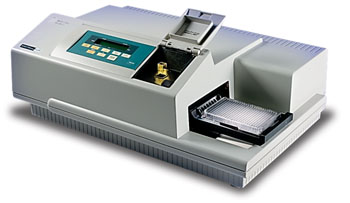Immunoassay Evaluated for Quantitative Measurement of Fecal α1-Antitrypsin
By LabMedica International staff writers
Posted on 09 Aug 2016
The measurement of the protease α1-antitrypsin (A1A) in stool specimens can be used to detect the presence of serum proteins in the gastrointestinal tract a sign of protein-losing enteropathy (PLE).Posted on 09 Aug 2016
The major causes of PLE can be divided into erosive and non-erosive gastrointestinal disorders, as well as increased central venous pressure or mesenteric lymphatic obstruction and among such disorders are enteritis, Crohn disease, ulcerative colitis, and celiac disease.

Image: The SPECTRAmax PLUS plate reader (Photo courtesy of Molecular Devices).
Scientists at the Associated Regional and University Pathologists (ARUP) Laboratories (Salt Lake City, UT, USA) used residual stool specimens sent to ARUP laboratories for fecal A1A testing, as well as paired sera and timed stool samples obtained from healthy volunteers. A1A in stool was measured with a polyclonal antibody-based enzyme-linked immunosorbent assay (ELISA). Assay imprecision, analytical sensitivity, linearity, accuracy, analyte stability, and reference intervals were determined.
Stool A1A was measured by using the Human α1-Antitrypsin ELISA (ImmuChrom, Heppenheim, Germany). This assay is a polyclonal immunometric method used for quantifying the A1A extracted from stool. Signals for ELISA plates were quantified with a SPECTRAmax PLUS plate reader (Molecular Devices LLC, Sunnyvale, CA, USA). Reference intervals for stool A1A and A1A clearance were established using timed stool samples and sera collected from 124 healthy volunteers (62 males, 62 females; ages 19–61 years).
The investigators found that the limit of quantification of the ELISA method used was 2.0 ng/mL, and the assay was linear to 85 ng/mL. The mean recovery of A1A added to samples was 108.2% and A1A was stable in stool for a minimum of two days, seven days, and three months at room temperature, 4 °C to 8 °C and −20 °C, respectively. The upper 95th percentile reference limits for A1A in stool and A1A clearance were 0.48 mg/g and 49 mL/day, respectively.
The authors concluded that the ImmuChrom human A1A ELISA demonstrates acceptable performance characteristics for quantifying A1A in stool extracts. Furthermore, this stool ELISA may be used in combination with the Tina-Quant A1A serum assay (Roche Diagnostics, Basel Switzerland) to assess A1A clearance for diagnosing and monitoring PLE. The study was published in the July 2016 issue of the Journal of Applied Laboratory Medicine.
Related Links:
Associated Regional and University Pathologists Laboratories
ImmuChrom
Molecular Devices
Roche Diagnostics













